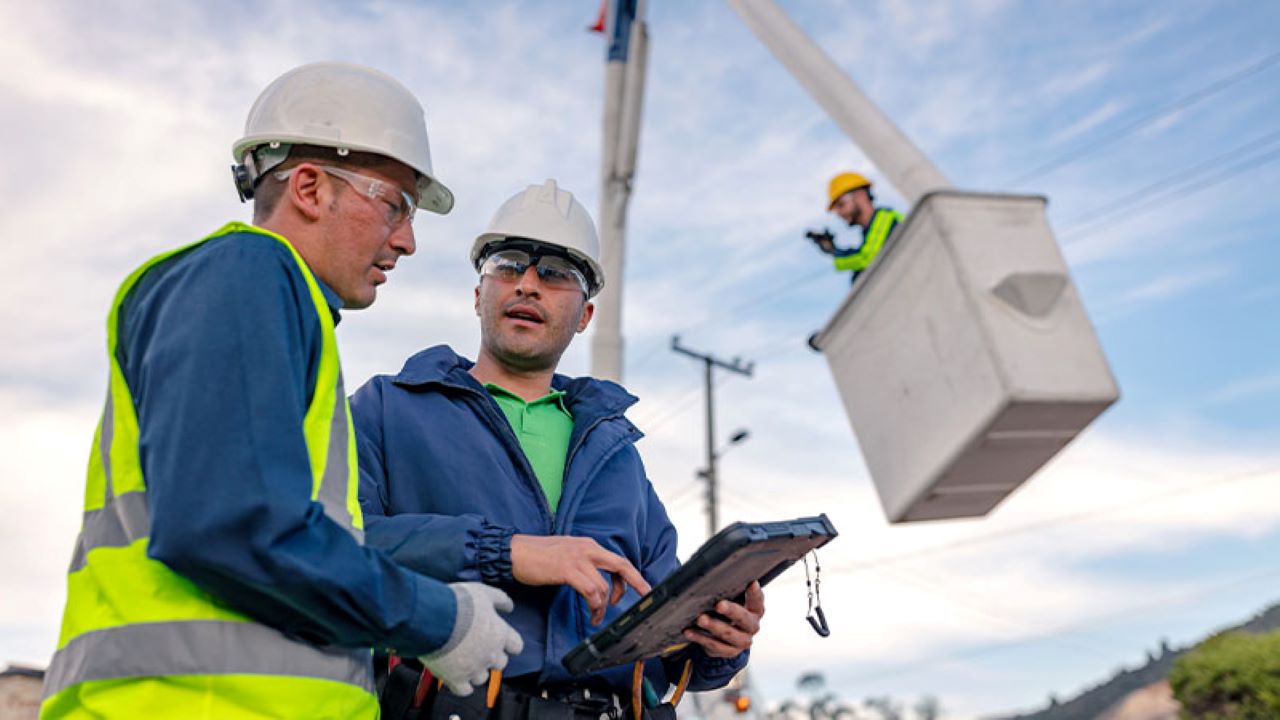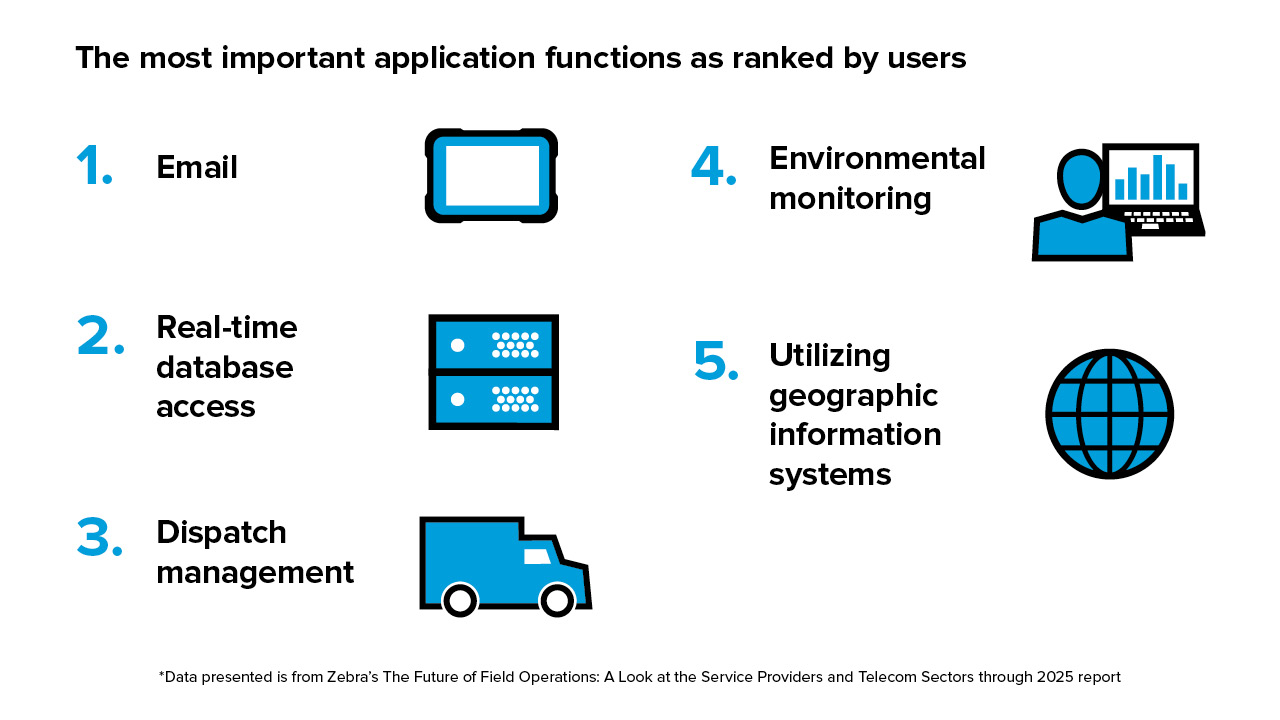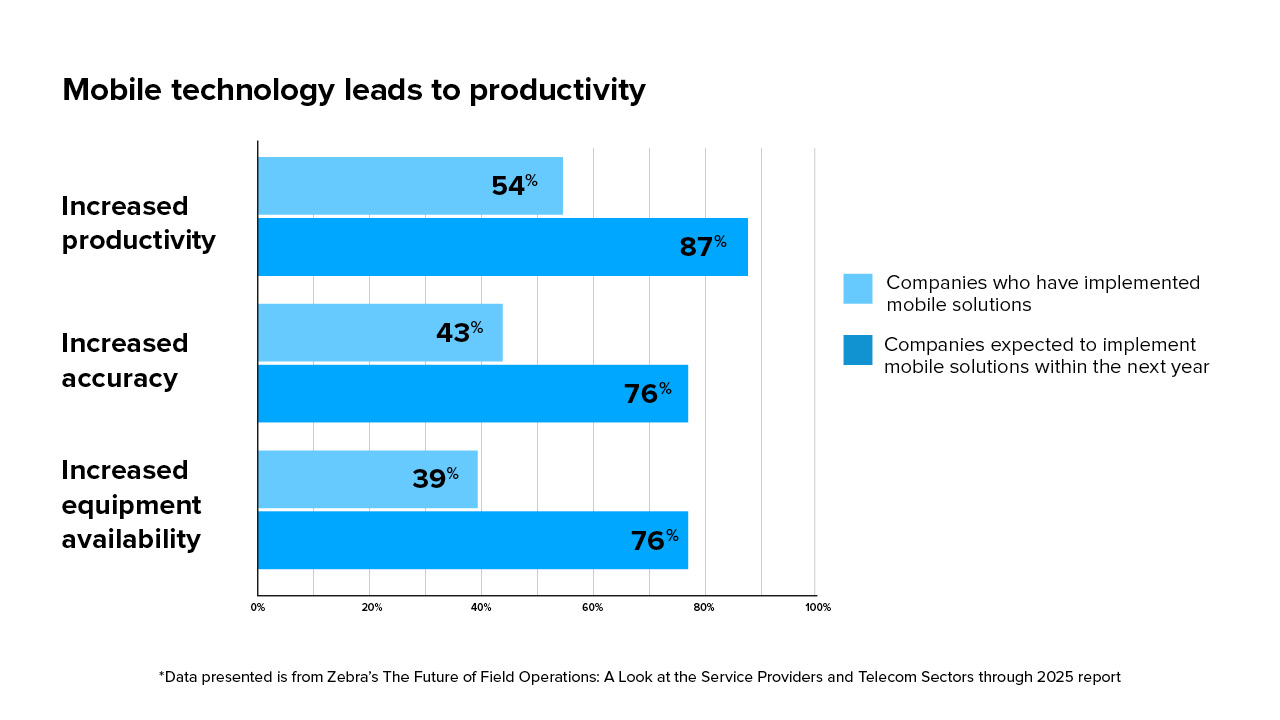Transform retail operations with Zebra’s retail technology solutions, featuring hardware and software for improving inventory management and empowering teams.
Streamline operations with Zebra’s healthcare technology solutions, featuring hardware and software to improve staff collaboration and optimize workflows.
Enhance processes with Zebra’s manufacturing technology solutions, featuring hardware and software for automation, data analysis, and factory connectivity.
Zebra’s transportation and logistics technology solutions feature hardware and software for enhancing route planning, visibility, and automating processes.
Learn how Zebra's public sector technology solutions empower state and local governments to improve efficiency with asset tracking and data capture devices.
Zebra's hospitality technology solutions equip your hotel and restaurant staff to deliver superior customer and guest service through inventory tracking and more.
Zebra's market-leading solutions and products improve customer satisfaction with a lower cost per interaction by keeping service representatives connected with colleagues, customers, management and the tools they use to satisfy customers across the supply chain.
Empower your field workers with purpose-driven mobile technology solutions to help them capture and share critical data in any environment.
Zebra's range of Banking technology solutions enables banks to minimize costs and to increase revenue throughout their branch network. Learn more.
Zebra's range of mobile computers equip your workforce with the devices they need from handhelds and tablets to wearables and vehicle-mounted computers.
Zebra's desktop, mobile, industrial, and portable printers for barcode labels, receipts, RFID tags and cards give you smarter ways to track and manage assets.
Zebra's 1D and 2D corded and cordless barcode scanners anticipate any scanning challenge in a variety of environments, whether retail, healthcare, T&L or manufacturing.
Zebra's extensive range of RAIN RFID readers, antennas, and printers give you consistent and accurate tracking.
Choose Zebra's reliable barcode, RFID and card supplies carefully selected to ensure high performance, print quality, durability and readability.
Zebra's rugged tablets and 2-in-1 laptops are thin and lightweight, yet rugged to work wherever you do on familiar and easy-to-use Windows or Android OS.
With Zebra's family of fixed industrial scanners and machine vision technologies, you can tailor your solutions to your environment and applications.
Zebra’s line of kiosks can meet any self-service or digital signage need, from checking prices and stock on an in-aisle store kiosk to fully-featured kiosks that can be deployed on the wall, counter, desktop or floor in a retail store, hotel, airport check-in gate, physician’s office, local government office and more.
Adapt to market shifts, enhance worker productivity and secure long-term growth with AMRs. Deploy, redeploy and optimize autonomous mobile robots with ease.
Discover Zebra’s range of accessories from chargers, communication cables to cases to help you customize your mobile device for optimal efficiency.
Zebra's environmental sensors monitor temperature-sensitive products, offering data insights on environmental conditions across industry applications.
Zebra's location technologies provide real-time tracking for your organization to better manage and optimize your critical assets and create more efficient workflows.
Enhance frontline operations with Zebra’s AI software solutions, which optimize workflows, streamline processes, and simplify tasks for improved business outcomes.
Empower your frontline with Zebra Companion AI, offering instant, tailored insights and support to streamline operations and enhance productivity.
The everything you need to rapidly and cost effectively develop high-performance AI vision applications on Zebra mobile computers.
Zebra Frontline AI Blueprints deliver adaptable, real-world AI frameworks that automate manual tasks and drive efficiency in high-pressure frontline operations.
Zebra Workcloud, enterprise software solutions boost efficiency, cut costs, improve inventory management, simplify communication and optimize resources.
Keep labor costs low, your talent happy and your organization compliant. Create an agile operation that can navigate unexpected schedule changes and customer demand to drive sales, satisfy customers and improve your bottom line.
Drive successful enterprise collaboration with prioritized task notifications and improved communication capabilities for easier team collaboration.
Get full visibility of your inventory and automatically pinpoint leaks across all channels.
Reduce uncertainty when you anticipate market volatility. Predict, plan and stay agile to align inventory with shifting demand.
Drive down costs while driving up employee, security, and network performance with software designed to enhance Zebra's wireless infrastructure and mobile solutions.
Explore Zebra’s printer software to integrate, manage and monitor printers easily, maximizing IT resources and minimizing down time.
Make the most of every stage of your scanning journey from deployment to optimization. Zebra's barcode scanner software lets you keep devices current and adapt them to your business needs for a stronger ROI across the full lifecycle.
RFID development, demonstration and production software and utilities help you build and manage your RFID deployments more efficiently.
RFID development, demonstration and production software and utilities help you build and manage your RFID deployments more efficiently.
Zebra DNA is the industry’s broadest suite of enterprise software that delivers an ideal experience for all during the entire lifetime of every Zebra device.
Advance your digital transformation and execute your strategic plans with the help of the right location and tracking technology.
Boost warehouse and manufacturing operations with Symmetry, an AMR software for fleet management of Autonomous Mobile Robots and streamlined automation workflows.
The Zebra Aurora suite of machine vision software enables users to solve their track-and-trace, vision inspection and industrial automation needs.
Zebra Aurora Focus brings a new level of simplicity to controlling enterprise-wide manufacturing and logistics automation solutions. With this powerful interface, it’s easy to set up, deploy and run Zebra’s Fixed Industrial Scanners and Machine Vision Smart Cameras, eliminating the need for different tools and reducing training and deployment time.
Aurora Imaging Library™, formerly Matrox Imaging Library, machine-vision software development kit (SDK) has a deep collection of tools for image capture, processing, analysis, annotation, display, and archiving. Code-level customization starts here.
Aurora Design Assistant™, formerly Matrox Design Assistant, integrated development environment (IDE) is a flowchart-based platform for building machine vision applications, with templates to speed up development and bring solutions online quicker.
Designed for experienced programmers proficient in vision applications, Aurora Vision Library provides the same sophisticated functionality as our Aurora Vision Studio software but presented in programming language.
Aurora Vision Studio, an image processing software for machine & computer vision engineers, allows quick creation, integration & monitoring of powerful OEM vision applications.
Adding innovative tech is critical to your success, but it can be complex and disruptive. Professional Services help you accelerate adoption, and maximize productivity without affecting your workflows, business processes and finances.
Zebra's Managed Service delivers worry-free device management to ensure ultimate uptime for your Zebra Mobile Computers and Printers via dedicated experts.
Find ways you can contact Zebra Technologies’ Support, including Email and Chat, ask a technical question or initiate a Repair Request.
Zebra's Circular Economy Program helps you manage today’s challenges and plan for tomorrow with smart solutions that are good for your budget and the environment.
The Zebra Knowledge Center provides learning expertise that can be tailored to meet the specific needs of your environment.
Zebra has a wide variety of courses to train you and your staff, ranging from scheduled sessions to remote offerings as well as custom tailored to your specific needs.
Build your reputation with Zebra's certification offerings. Zebra offers a variety of options that can help you progress your career path forward.
Build your reputation with Zebra's certification offerings. Zebra offers a variety of options that can help you progress your career path forward.

Telcos: Consider Implementing These Technologies to Improve Service Call Response Times and Your Bottom Line
According to Zebra’s “Future of Field Operations” report, telcos and other service providers appreciate the potential impact of more advanced technology tools such as remote monitoring and reporting, predictive analytics, machine learning, augmented reality and autonomous vehicles. Despite technology implementations and adaptation being flagged as an operational challenge, significant investments are being made to implement these technologies across different operational functions, with adoption of these technologies forecasted to grow two to three times over the next few years.
In my estimation, this proves there is demonstrated value in technologies that empower front-line workers to sense, analyze and act on potential issues. Servicing right before a failure is infinitely better than any time after a failure.

Perhaps more interesting are the reported benefits of using mobile technologies which, as we’ve talked about before here on the Your Edge blog, are critical to capturing and then redistributing the data needed to sense, analyze and then act on what’s happening at the operational edge:

Even more beneficial than the positives of reduced operating costs and liability exposure is the increase in worker satisfaction. I think there are two reasons for this improved worker satisfaction:
- Having the right tools to be successful is rewarding to individuals.
- The fact that the organization is supporting and investing in its workers can have a profound impact on employee morale and drive greater adoption.
In a way, mobile technology adoption in field service environments mirrors the adoption trends of automotive safety systems discussed in my previous blog post. While many consumers didn’t necessarily ask for advanced driver assistance systems (ADAS) technologies, people who eventually experienced them ended up relying on them and insisting that their next vehicle include these features. And those few features that didn’t work well out of the gate were immediately prioritized for improvement, not removal.
For example, Cadillac, an industry leader in Lane Departure Warning and other ADAS features, first implemented a system that beeped if the car was drifting toward the edge of the lane. It warned both the driver and the other vehicle occupants that the driver made a mistake. That was short lived. At first, engineers changed it into a vibration-only notification style, then quickly evolved to an automated feature that would gently move the car back to the center of the lane. Most cars with Lane Departure systems now guide the car back to the center with the option for driver override, if necessary.
Similarly, there was some hesitation to implement mobile technologies when they first became available several decades ago because service providers didn’t want to disrupt workflows or introduce any more complexity to already-complex business processes. Plus, there’s always uncertainty in the unknown: will it work as promised and deliver the return on investment (ROI) needed to justify such significant operational changes?
Fortunately, service providers who were very strategic in their mobile solution designs and deployments proved to others that the rewards far outweigh any perceived risks – and that most of those risks can be mitigated by investing in the right mobile technology hardware and software components for the job at hand.
That leads us to another key finding from Zebra’s “Future of Field Operations” study: rugged devices are absolutely preferred right now in the telecom and field service sectors. Whether it is determined that a smartphone-type handheld mobile computer or full-size tablet is the better form factor for certain workers and workflows, organizations insist that they must be “rugged.”

Why rugged? Because mobility tools must be available to workers at all times in order to be valuable to any organization with field operations. These computing devices are how telco equipment installers and maintainers capture and access critical operational data in real time in harsh environments. If they go down for any reason, then workers and, potentially, equipment could go offline. That is why around-the-clock device availability is driving purchasing decisions in this sector right now, not reduced purchase price (which, ironically, increases downstream costs).
As the study results show, the fundamental mobile workflow functions that are deemed most critical require a constant level of wireless network connectivity, secure access to specialized business systems and easy viewability of detailed images and graphics, even in direct sunlight. They also require an extreme level of device reliability. These aren’t actions that can be managed easily offline.

For example, your technicians can’t access geographic information systems (GIS) to map environmental reports into a real-time database to which they were dispatched if their mobile devices are out of operation.
Now, I’ve heard some field service organizations say that they don’t believe enterprise-grade rugged devices are different enough from commercial or even consumer devices to warrant their purchase price. They don’t understand what could be that different.
This too happens a lot when automotive makers talk about the benefits of certain technology features that will save us from those rare but real moments of inattention. Lots of drivers don’t understand how ADAS could possibly work. How can the car know if I’m wandering or want to move toward the lane markings? Whether you understand how it could work or not, it does work in the vast majority of cases. And it is designed to help you when you need it while never removing control from the driver – you can still intervene at the moment it’s needed, if needed.
This is often attributed to a logical fallacy called “Argument from Incredulity” which states “Since I don’t understand it, it can’t be true.”
“Flat earthers,” it might be said, fall for this logical fallacy.
However, failing to trust in the communicated (and proven) benefits of ADAS or enterprise-grade, rugged-to-the-core technologies is highly risky.
Truly rugged devices – the ones needed to keep field service workers online and productive in harsh and remote environments – aren’t made rugged by just adding rubber bumpers to the frame or using a “protective” case. Thousands of decisions made during the design phase of these devices are based on the anticipated field use and decades of experience studying, testing and truly understanding the functional form requirements for certain use cases and environments. Power connectors are hard mounted internally, not just soldered on the printed circuit board, because that has been identified as a known failure point, just to give you one example.
Therefore, a decision about whether or not you, as a service provider, should use truly rugged, enterprise-grade devices should be based on whether or not you have the need for rugged devices at all. You must calculate the value of uptime and the cost of an idled service person and disappointed customer.
Don’t assume that mobile devices sharing the same basic shapes operate the same way or offer the same feature set or workflow capabilities. Purpose-built rugged handheld computers and tablets are designed from the ground up to perform differently, and they will make a world of difference on your organization’s ROI, your customer’s satisfaction and your workers’ happiness.
Why?
The 400+ service provider decision makers who responded to Zebra’s “Future of Field Ops” study said it best: the use of advanced technologies to “sense, analyze and act on issues” and the dependable (i.e. rugged) mobile devices that enable these advanced technologies to work to their full potential ultimately yields increased productivity, increased accuracy (first time fix rate) and increased equipment availability. Many actually expect the use of mobile devices to roughly double these benefits within the next year!

In other words, telecom and field service organizations that want to maximize the output of their workers and equipment and mitigate costly mistakes, oversights and system failures use the best technology tools available today and invest in better ones when they become available tomorrow. Strategic modernization matters. It also drives measurable improvements in customer satisfaction, cost control and employee retention.
Zebra Developer Blog
Zebra Developer BlogZebra Developer Blog
Are you a Zebra Developer? Find more technical discussions on our Developer Portal blog.
Zebra Story Hub
Zebra Story HubZebra Story Hub
Looking for more expert insights? Visit the Zebra Story Hub for more interviews, news, and industry trend analysis.
Search the Blog
Search the BlogSearch the Blog
Use the below link to search all of our blog posts.
Most Recent
Legal Terms of Use Privacy Policy Supply Chain Transparency
ZEBRA and the stylized Zebra head are trademarks of Zebra Technologies Corp., registered in many jurisdictions worldwide. All other trademarks are the property of their respective owners. Note: Some content or images on zebra.com may have been generated in whole or in part by AI. ©2025 Zebra Technologies Corp. and/or its affiliates.




